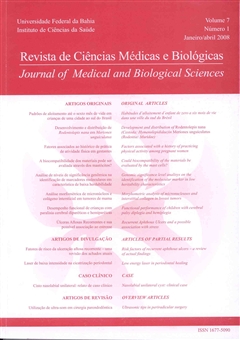Development and distribution of Rodentolepis nana (Cestoda: Hymenolepididae) in Meriones unguiculatus (Rodentia: Muridae)
DOI:
https://doi.org/10.9771/cmbio.v7i1.4353Keywords:
Rodentolepis nana, Meriones unguiculatus, Dexamethasone, Host-parasite relationship.Abstract
In order to evaluate the development and distribution of Rodentolepis nana in Meriones unguiculatus, twenty animals had been orally infected with 100 eggs of R. nana each, half of them daily treated subcutaneously with dexamethasone (DMS) (10mg/Kg). At the 7th and 15th day post-infection (DPI) five animals of each group were sacrificed for parasite recovery. In DMS untreated- M. unguiculatus, parasites were recovered only at the 7th DPI, in early stage of maturation and distributed mainly through the distal portion of this rodent small intestine. In the same date, the parasites recovered in DMS treated- M. unguiculatus were probably in the same developmental stage of those parasites found in untreated ones, although distributed through median and distal portions of the small intestine. The parasites recovered in DMS treated- M. unguiculatus were fully developed, showing sexually mature and gravid proglottids, distributed mainly through the median portion, and secondarily, through the distal portion of the small intestine. It is concluded that M. unguiculatus has reduced potential as reservoir of this cestode and its resistance to the R. nana infection has an important inflammatory component, sensible to DMS action.Downloads
Download data is not yet available.
Downloads
Published
2008-10-13
How to Cite
Vianna, G. J. C., & Melo, A. L. de. (2008). Development and distribution of Rodentolepis nana (Cestoda: Hymenolepididae) in Meriones unguiculatus (Rodentia: Muridae). Journal of Medical and Biological Sciences, 7(1), 16–22. https://doi.org/10.9771/cmbio.v7i1.4353
Issue
Section
ORIGINAL ARTICLES
License
The Journal of Medical and Biological Sciences reserves all copyrights of published works, including translations, allowing, however, their subsequent reproduction as transcription, with proper citation of source, through the Creative Commons license. The periodical has free and free access.


